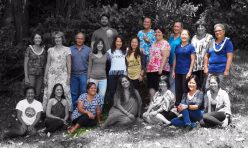2019-2020
Kumu: Māhealani Chang
Ka Nu‘ukia – Vision: The excellent haumāna will acquire, understand, articulate, and practice ‘ōlelo and moʻomeheu Hawai‘i (Hawaiian language and culture) skills that will strengthen his/her Hawaiian identity.
Nā Keiki o ka ‘Āina – Papa 6 is called “Nā Keiki o ka ‘Āina” which means “The Young Kalo Plants of the Land”. Each sixth grade homeroom is named after a type of kalo Hawaiʻi.
Ka Hoʻolauna – Haumāna will share their latest hoʻolauna (introduction) speech incorporating sibling and birth order terms learned during Papa 5. This presentation will be part of their kuleana as Alakaʻi during Piko Wehena.
Ka Pule a ka Haku – Haumāna will learn “The Lord’s Prayer” in Hawaiian in order to build further understanding of Ke Aliʻi Pauahi’s Christian faith.
Ka Moʻokūʻauhau – Haumāna will learn more about the significance of moʻokūʻauhau (genealogy). We will utilize the moʻolelo of Adam and Eve and their children Cain and Abel, as well as the moʻolelo of Wākea and Papahānaumoku, the birth of our pae ʻāina, Hoʻohōkūkalani, Hāloanakalaukapalili, and Hāloa.
Ke Aloha ʻĀina – Haumāna will learn more about aloha ʻāina (Hawaiian patriotism; love for the land and its people) through the mele “Kū Haʻaheo e Kuʻu Hawaiʻi” (oli) and “For The Lāhui” (hula). Performance of these mele will occur during our KES Lā Kūʻokoʻa celebration and ʻOnipaʻa Kākou observance.
Ka Pōʻaiapuni Pāʻani Hawaiʻi – During the Hawaiian Games Cycle (Nowemapa 5-18) in celebration of Makahiki, haumāna will experience ihe pahe‘e (spear sliding) and ‘ō‘ō ihe (spear throwing) to test their form, strength, and accuracy. They will also play a modified two-person hukihuki (tug-of-war) to test their agility, strategy, and balance.
Ko‘u ‘Ohana, Ko‘u Mo‘okū‘auhau – Each haumāna will learn to recite a part of his/her own genealogy/family history in ‘ōlelo Hawai‘i. Understanding of cultural terms such as pilina, ‘ohana, mo‘okū‘auhau, hānau and hānai will be expanded upon. Haumāna will have various options toward completing the assignment, thus allowing for flexibility as needed from ʻohana to ʻohana. Haumāna will have choices in what they decide to share.
He Inoa no Pauahi – Haumāna will continue to build hula skills in order to perform a modified version of “He Inoa no Pauahi” (composed by Mary Kawena Pukui) at Mauna ʻAla. This hoʻokupu will ceremonially mark the ending of their educational journey at Ke Kula Ha‘aha‘a ʻo Kamehameha ma Kapālama and their moving forward toward middle school. I Mua Kamehameha!

machang@ksbe.edu

